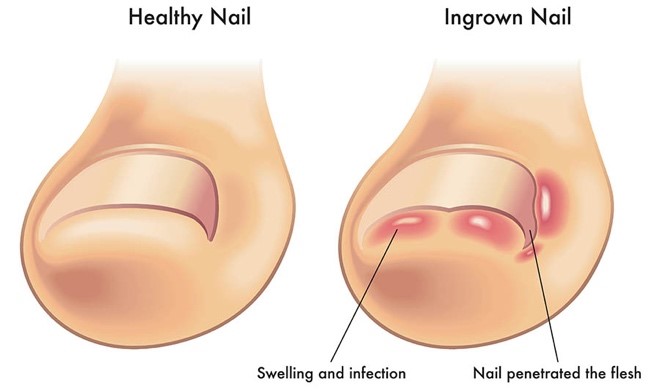Ingrown toenails, or onychocryptosis, are a common foot issue that many people encounter at some point. This condition occurs when the corner or side of a toenail grows into the surrounding tissue, leading to pain, redness, and swelling. Most often affecting the big toe, ingrown toenails can also occur on other toes, and if left untreated, they may lead to infection. Podiatrists are trained to be able to diagnose, treat and prevent ingrown toenails. Find out more on our Podiatry page.
Who’s at Risk?
While anyone can develop an ingrown toenail, certain groups are more susceptible, including:
- Diabetics: Increased risk due to potential foot complications.
- Those in Tight Footwear: High heels and tight shoes can exacerbate the issue.
- Individuals with Nerve Damage or Compromised Immunity: Reduced sensation or immune response can worsen the condition.
- Athletes: Runners and those involved in kicking sports are particularly prone to ingrown nails.
Causes of Ingrown Toenails
The primary culprit behind ingrown toenails is the nail’s edge penetrating the surrounding tissue. Several factors contribute to this issue:
- Poor Nail Care: Neglecting proper nail trimming techniques.
- Foot Hygiene: Inadequate cleaning can lead to problems.
- Nail Deformities: Genetic factors may cause nails to curve.
- Ill-fitting Footwear: Shoes that are too tight can push nails into the skin.
- Trauma: Injuries to the toe can trigger ingrowth.
Potential Complications
Ignoring an ingrown toenail can lead to several complications:
- Pain and swelling
- Ulceration
- Hypergranulation (excessive tissue growth)
- Infection
Early treatment is crucial to prevent these complications from arising.
Treatment Options
Treatment varies depending on the severity of the ingrown toenail and the individual’s health history. Here’s what to expect:
For Mild Cases:
- Education on nail care and foot hygiene
- Cleaning under the nail
- Soaking feet in lukewarm salt baths
- Adjusting footwear choices
For Moderate to Severe Cases:
- Partial removal of the ingrown nail
- Appropriate wound dressings
- Chemical cautery to reduce hypergranulation
- Possible referral to a GP for infection management
In severe or chronic cases, procedures like partial nail avulsion (PNA) or total nail avulsion (TNA) may be considered.
Prevention Strategies
The best approach to ingrown toenails is prevention. Here are some effective strategies:
- Practice Good Hygiene: Regular cleaning and care can help.
- Wear Appropriate Footwear: Choose shoes that fit well and offer support.
- Cut Nails Correctly: Trim nails straight across and keep them at a moderate length.
- Monitor Your Feet: Regular checks are vital, especially for those with existing health conditions.
- Avoid Picking: Refrain from ripping or digging at nails.
Conclusion
Ingrown toenails can be painful and disruptive, but they are often preventable. By implementing good foot care practices and consulting a Podiatrist at the first sign of trouble, you can manage and treat ingrown toenails effectively. Don’t let foot pain slow you down—take proactive steps to keep your feet healthy!
To learn more about Plena’s Podiatry services, visit our Podiatry page : Aged Care Podiatry | In Home Podiatry | Plena Healthcare




